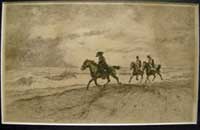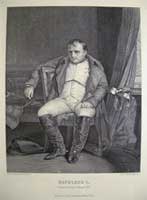Ref. TJ 1 /DNN/ V.ande > ENN PRICE CODE B SOLD Click here for price guide
The Battle of Laon (9–10 March 1814) was the victory of Blücher's Prussian army over Napoleon's French army near Laon. This setback did not by itself spell the end for Napoleon. Just a few days later the French crushed an isolated enemy corps at Rheims. Blücher's Army of Silesia remained inactive for a week after the victory. Nevertheless, the Allied stand had prevented Napoleon from driving them further north. The Allies were still in a position to advance on Paris, which they did at the end of March. Wikipedia
The vast expanse of desolate plain and leaden sky give breadth to the scene as does the dilated perspective around the central figure of the Emperor magnified by a slightly low angle. The smallest details are minutely recorded: Napoleon's sprouting beard, the veins on the horse's legs, the snow dirtied by the marching troops... the Director of the Ecole des Beaux Arts, Charles Blanc, said that Meissonier "painted grandly in a small size". The artist applied the same meticulous approach, but as a historian this time, to his preparatory research: he collected abundant documentation, questioned many eyewitnesses and tried unsuccessfully to borrow the Emperor's grey coat. The episode he has chosen, although it occurred after several victories, announces forthcoming defeats. There is no action or event, just an atmosphere of loneliness and despondency. The doubts and resignation felt by the officers and the troops are palpable and are opposed to the determination that emanates from the isolated figure of Napoleon. These feelings are accentuated by the colour range: the whole scene uses brown and grey tones, subdued, deadened registers. The protagonists are not trampling virgin snow, but muddy ground.
BACK TO THE TOP















